The Train Control and Management Systems Market is estimated to be valued at USD 3.8 billion in 2025 and is projected to reach USD 9.8 billion by 2035, registering a compound annual growth rate (CAGR) of 9.8% over the forecast period.
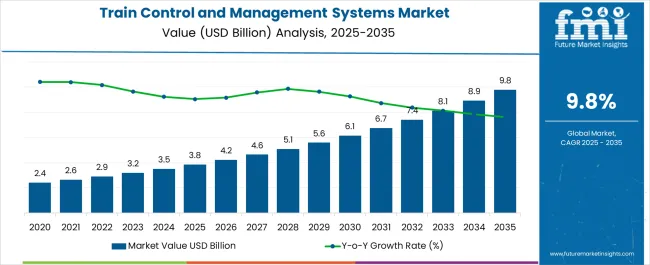
| Metric | Value |
|---|---|
| Train Control and Management Systems Market Estimated Value in (2025 E) | USD 3.8 billion |
| Train Control and Management Systems Market Forecast Value in (2035 F) | USD 9.8 billion |
| Forecast CAGR (2025 to 2035) | 9.8% |
The Train Control and Management Systems market is witnessing robust growth, driven by the increasing demand for advanced rail transportation solutions and the need to enhance operational safety, efficiency, and reliability. Adoption is being fueled by the global push for modernization of rail networks, including high-speed, urban, and commuter train systems. Communication-based train control, automated signaling, and real-time monitoring technologies are being implemented to optimize train operations and reduce delays, energy consumption, and operational costs.
Investments in smart rail infrastructure, government initiatives to improve public transport efficiency, and growing urbanization are contributing to market expansion. Integration of train control solutions with modern signaling and onboard management systems is improving overall network performance and safety compliance.
Additionally, technological advancements in data analytics, sensor systems, and embedded control units are enabling predictive maintenance and enhanced situational awareness As railway operators increasingly prioritize automation, safety, and interoperability, the Train Control and Management Systems market is positioned for sustained growth in both developed and emerging regions.
The train control and management systems market is segmented by type of train, train control solution, component, network type, and geographic regions. By type of train, train control and management systems market is divided into EMU – Electric Multiple Unit, DMU – Diesel Multiple Unit, Bullet Trains, and Subway Or Metro Trains. In terms of train control solution, train control and management systems market is classified into Communication Based Train Control, Positive Train Control, and Integrated Train Control. Based on component, train control and management systems market is segmented into Computer Control Units, Modular Input/Output Devices, Human Machine Interface, and Mobile Communication Gateway. By network type, train control and management systems market is segmented into ECN – Ethernet Consist Network, MVB – Multifunctional Vehicle Bus, WTB – Wired Train Bus, and Others. Regionally, the train control and management systems industry is classified into North America, Latin America, Western Europe, Eastern Europe, Balkan & Baltic Countries, Russia & Belarus, Central Asia, East Asia, South Asia & Pacific, and the Middle East & Africa.
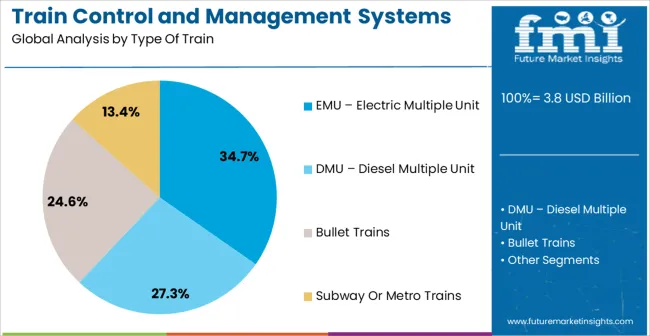
The EMU – Electric Multiple Unit segment is projected to hold 34.7% of the market revenue in 2025, making it the leading train type. Growth in this segment is being driven by the increasing adoption of EMUs for urban, suburban, and regional rail services due to their energy efficiency, high acceleration, and ability to handle frequent stops. EMUs support the integration of advanced train control systems and onboard management solutions, which enhance safety, scheduling, and operational efficiency.
The modular design and scalability of EMUs allow seamless incorporation of communication-based control technologies and computer control units, improving system interoperability and reducing maintenance requirements. Investment in electrified rail networks, particularly in densely populated regions, has reinforced demand for EMUs.
Additionally, the ability to implement automated train operation and real-time monitoring has further strengthened adoption As transportation authorities prioritize modernization and energy-efficient solutions, EMUs are expected to maintain their leadership in the train type segment, supported by technological advancements and increasing urban rail deployments.
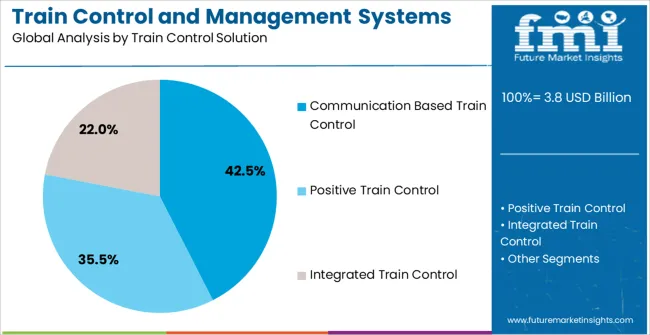
The communication-based train control segment is anticipated to account for 42.5% of the market revenue in 2025, establishing it as the leading train control solution. Growth is being driven by the need for real-time signaling, automation, and enhanced safety in modern rail networks. Communication-based control enables continuous monitoring of train positions, speeds, and operational parameters, allowing for optimized scheduling, reduced headways, and higher line capacity.
Integration with onboard computer control units and predictive maintenance systems improves operational reliability and reduces downtime. Investments in high-speed and urban rail infrastructure, along with government initiatives to enhance public transportation safety, are supporting adoption.
The technology allows dynamic adjustment of train operations in response to network conditions, improving energy efficiency and passenger experience As railway operators increasingly seek automated, interoperable, and efficient control systems, communication-based train control is expected to remain the dominant solution, driving the overall growth of the Train Control and Management Systems market.
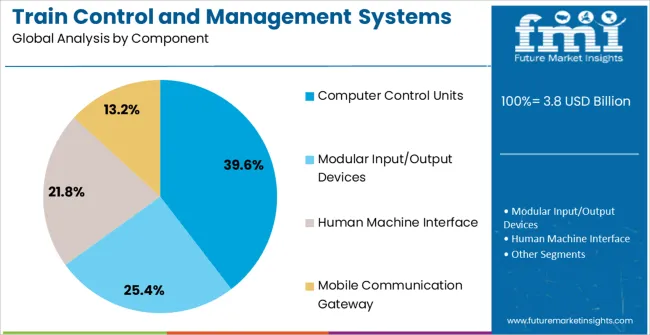
The computer control units segment is projected to hold 39.6% of the market revenue in 2025, making it the leading component type. Growth in this segment is being driven by the increasing reliance on advanced onboard computing systems to manage train operations, control signaling, and integrate communication-based train control solutions.
Computer control units enable real-time monitoring, predictive maintenance, and data-driven decision-making, which enhance operational safety, efficiency, and reliability. Their ability to process large volumes of data and interface with sensors, signaling systems, and management software supports the automation of train functions and the optimization of energy usage.
Adoption is further reinforced by the expansion of high-speed and urban rail networks, where precise control and interoperability are critical As railway operators prioritize automation, reliability, and system integration, computer control units are expected to remain the core component of train control and management systems, maintaining a leading share in the market and supporting the deployment of advanced rail infrastructure.
Major emphasis given to railway security and safety are creating a demand for advanced solutions such as train control and management systems that help in real-time monitoring and management of train systems. This is executed effectively with the help of advanced radio equipment and high-performance monitoring solutions.
The train control and management systems providers such as Mitsubishi Electric Corporation are working towards providing radio equipment for this purpose. Another player, Hitachi launched the new signaling software which is designed to improve productivity and reduce errors.
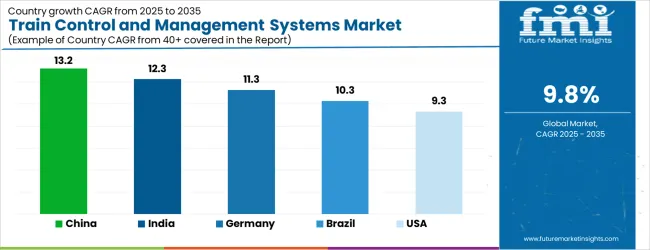
| Country | CAGR |
|---|---|
| China | 13.2% |
| India | 12.3% |
| Germany | 11.3% |
| Brazil | 10.3% |
| USA | 9.3% |
| UK | 8.3% |
| Japan | 7.4% |
The Train Control and Management Systems Market is expected to register a CAGR of 9.8% during the forecast period, exhibiting varied country level momentum. China leads with the highest CAGR of 13.2%, followed by India at 12.3%. Developed markets such as Germany, France, and the UK continue to expand steadily, while the USA is likely to grow at consistent rates. Japan posts the lowest CAGR at 7.4%, yet still underscores a broadly positive trajectory for the global Train Control and Management Systems Market. In 2024, Germany held a dominant revenue in the Western Europe market and is expected to grow with a CAGR of 11.3%. The USA Train Control and Management Systems Market is estimated to be valued at USD 1.3 billion in 2025 and is anticipated to reach a valuation of USD 1.3 billion by 2035. Sales are projected to rise at a CAGR of 0.0% over the forecast period between 2025 and 2035. While Japan and South Korea markets are estimated to be valued at USD 187.5 million and USD 120.3 million respectively in 2025.
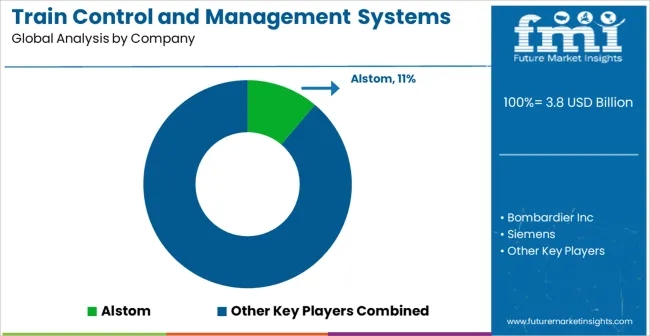
| Item | Value |
|---|---|
| Quantitative Units | USD 3.8 Billion |
| Type Of Train | EMU – Electric Multiple Unit, DMU – Diesel Multiple Unit, Bullet Trains, and Subway Or Metro Trains |
| Train Control Solution | Communication Based Train Control, Positive Train Control, and Integrated Train Control |
| Component | Computer Control Units, Modular Input/Output Devices, Human Machine Interface, and Mobile Communication Gateway |
| Network Type | ECN – Ethernet Consist Network, MVB – Multifunctional Vehicle Bus, WTB – Wired Train Bus, and Others |
| Regions Covered | North America, Europe, Asia-Pacific, Latin America, Middle East & Africa |
| Country Covered | United States, Canada, Germany, France, United Kingdom, China, Japan, India, Brazil, South Africa |
| Key Companies Profiled | Alstom, Bombardier Inc, Siemens, Hitachi Ltd, Mitsubishi Electric Corporation, Strukton, Wabtec Corporation, Toshiba Corporation, ThalesGroup, CAF Group, Selectron Systems AG, ABB, Knorr-Bremse AG, Indra Sistemas, DXC Technology, Trimble, and Frequentis |
The global train control and management systems market is estimated to be valued at USD 3.8 billion in 2025.
The market size for the train control and management systems market is projected to reach USD 9.8 billion by 2035.
The train control and management systems market is expected to grow at a 9.8% CAGR between 2025 and 2035.
The key product types in train control and management systems market are emu – electric multiple unit, dmu – diesel multiple unit, bullet trains and subway or metro trains.
In terms of train control solution, communication based train control segment to command 42.5% share in the train control and management systems market in 2025.






Our Research Products

The "Full Research Suite" delivers actionable market intel, deep dives on markets or technologies, so clients act faster, cut risk, and unlock growth.

The Leaderboard benchmarks and ranks top vendors, classifying them as Established Leaders, Leading Challengers, or Disruptors & Challengers.

Locates where complements amplify value and substitutes erode it, forecasting net impact by horizon

We deliver granular, decision-grade intel: market sizing, 5-year forecasts, pricing, adoption, usage, revenue, and operational KPIs—plus competitor tracking, regulation, and value chains—across 60 countries broadly.

Spot the shifts before they hit your P&L. We track inflection points, adoption curves, pricing moves, and ecosystem plays to show where demand is heading, why it is changing, and what to do next across high-growth markets and disruptive tech

Real-time reads of user behavior. We track shifting priorities, perceptions of today’s and next-gen services, and provider experience, then pace how fast tech moves from trial to adoption, blending buyer, consumer, and channel inputs with social signals (#WhySwitch, #UX).

Partner with our analyst team to build a custom report designed around your business priorities. From analysing market trends to assessing competitors or crafting bespoke datasets, we tailor insights to your needs.
Supplier Intelligence
Discovery & Profiling
Capacity & Footprint
Performance & Risk
Compliance & Governance
Commercial Readiness
Who Supplies Whom
Scorecards & Shortlists
Playbooks & Docs
Category Intelligence
Definition & Scope
Demand & Use Cases
Cost Drivers
Market Structure
Supply Chain Map
Trade & Policy
Operating Norms
Deliverables
Buyer Intelligence
Account Basics
Spend & Scope
Procurement Model
Vendor Requirements
Terms & Policies
Entry Strategy
Pain Points & Triggers
Outputs
Pricing Analysis
Benchmarks
Trends
Should-Cost
Indexation
Landed Cost
Commercial Terms
Deliverables
Brand Analysis
Positioning & Value Prop
Share & Presence
Customer Evidence
Go-to-Market
Digital & Reputation
Compliance & Trust
KPIs & Gaps
Outputs
Full Research Suite comprises of:
Market outlook & trends analysis
Interviews & case studies
Strategic recommendations
Vendor profiles & capabilities analysis
5-year forecasts
8 regions and 60+ country-level data splits
Market segment data splits
12 months of continuous data updates
DELIVERED AS:
PDF EXCEL ONLINE
Cloud Systems Management Software Market Size and Share Forecast Outlook 2025 to 2035
Door Controller Systems Market
Change Control Management Software Market
Systems Administration Management Tools Market Size and Share Forecast Outlook 2025 to 2035
Version Control Systems Market Size and Share Forecast Outlook 2025 to 2035
Driveline Control Systems and Devices Market Size and Share Forecast Outlook 2025 to 2035
Vibration Control Systems Market Growth - Trends & Forecast 2025 to 2035
Aspiration Control Systems Market Size and Share Forecast Outlook 2025 to 2035
Electric Powertrain Systems Market Size and Share Forecast Outlook 2025 to 2035
Valve Remote Control Systems Market Analysis by Type, Application and Region - Forecast for 2025 to 2035
Home Energy Management Systems Market Size and Share Forecast Outlook 2025 to 2035
Battlefield Management Systems Market Size and Share Forecast Outlook 2025 to 2035
Translation Management Systems Market Analysis - Size, Share, and Forecast Outlook 2025 to 2035
EV Telematics Control Systems Market Size and Share Forecast Outlook 2025 to 2035
Competitive Overview of Air Pollution Control Systems Providers
Air Pollution Control Systems Market – Applications & Growth Forecast 2025-2035
Environmental Management Systems Market Size and Share Forecast Outlook 2025 to 2035
AGV Intelligent Management Systems Market Size and Share Forecast Outlook 2025 to 2035
Endoscopy Fluid Management Systems Market Size and Share Forecast Outlook 2025 to 2035
Retail Warehouse Management Systems Market Size and Share Forecast Outlook 2025 to 2035

Thank you!
You will receive an email from our Business Development Manager. Please be sure to check your SPAM/JUNK folder too.
Chat With
MaRIA